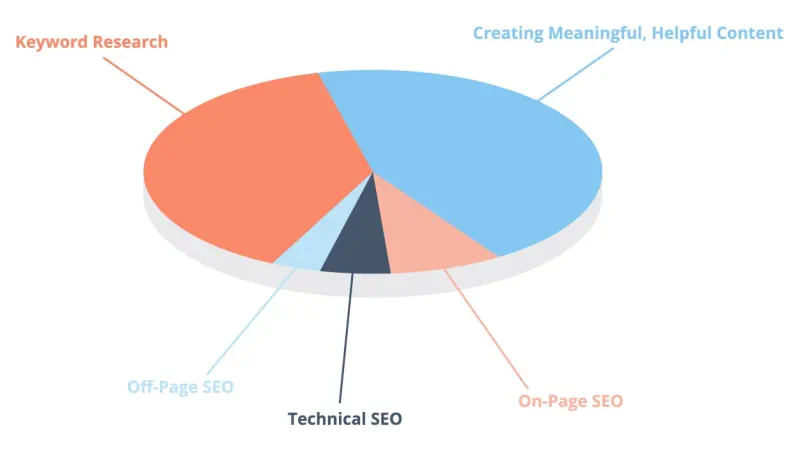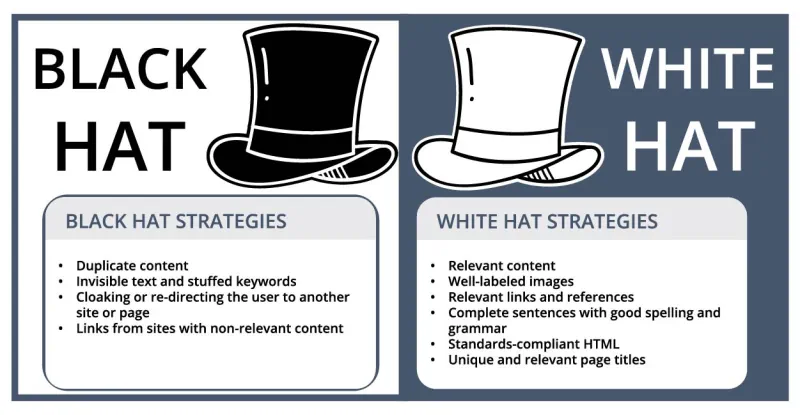SEO Basics: How To Use SEO To Get Your Business In Front Of Customers.
Chapter 2: The Fundementals of SEO
- 1
- 2
- 3
- 4
- 5
- 6
- 7
- 8
- 9
Have you ever really thought about what it is you use search engines for?
If you’re like most people you turn to search engines when you want to learn how to do something. Or if you are looking for the best price on something, or to find a service company to fix something, you probably turn to Google to look for that product or service.
When it comes right down to it, search engines are our own personal answer machines. We ask it for something, and it shows us ten or twenty options for what we need.
Back in the introduction for our SEO Beginner’s Guide, we said SEO was the process of increasing the visibility of your website in search results. The “Tricky” part is making sure that you are increasing that visibility for the search terms that will be meaningful to your bottom line.
That doesn’t always mean a direct sale, like with eCommerce. That can mean a lead, an opt-in, or any other conversion point you set, as long as it has a defined business purpose and objective.
Anyone can start writing blog posts about collecting obscure vintage toothpicks and might get some traffic out of it, but if your business doesn’t sell toothpicks, that doesn’t do you any good. On the other hand, if you were the toothpick king (or queen) of Cleveland, that might be fantastic content for your website that you wouldn’t have originally thought of when having a new website built.
Of course, an example like that won’t work for everyone.
Demystifying Cleveland Business SEO
When thinking about SEO for your Cleveland-based business, knowing that search engines are essentially giant answer machines, you have to consider what search terms you want your business to appear for.
In the case of products in an eCommerce store, that’s pretty straight forward in terms of what keywords you’d like to show up for. But what if you don’t sell anything right on your website. Then what?
(I know what is going to come next may sound like a lot of other articles you’ve read, but I’m going to tell you a secret right after it, so bare with me.)
If your business isn’t as straight forward as a storefront with products that you want to rank, you have to think about topics your customers might be searching for and need answers to, or insight on.
What other problems might they have that are related to what your business does? Some things to consider are:
- What questions are you qualified to answer?
- What solutions are you uniquely positioned to provide for your customers in a way none of your competitors can?
- What topics can you speak on, using your expertise to develop authority and trust in your business?
It’s okay if you don’t know right now, or can’t think of anything this minute. If you’re unclear on what I mean, maybe an example would help illustrate what we are talk about here.
Okay, ready for that secret?
If I tell you, you can’t tell anyone else. It has to stay between us. Promise?
Okay, clearly I can’t see you, but I can just tell you’re an honest person so I’m going to say it.
This entire SEO Beginners Guide is a SEO tactic.
Whew, okay, I feel better having gotten that off my chest!
Applying that secret to your business
Let’s reverse engineer this together.
As you probably figured out, we are Cleveland Web Works. Our business designs and develops websites, we help our clients with digital marketing, and we provide managed hosting services that takes all of the pressure off of people like yourself so you can focus on your customers, your employees, and most importantly your family and personal life without worrying about is going on with your website.
The number one reason people want to have websites built is so that their customers can find them online. That typically means SEO is going to be involved at some point.
So knowing that you are probably a business owner, or otherwise in charge of some aspect of your company’s digital presence, and have a need for more people to find your business online, we produced this expansive piece of content that teaches you how to do that.
Maybe you found this SEO guide when searching on Google, or a friend shared the link with you, but however you got here you are here because we put together this guide to help you succeed at your SEO related goals and business objectives.
You probably didn’t know who we were before this, but by creating helpful content that helps you solve your problem we’ve made that introduction – AND MOST IMPORTANTLY – you know that if you do need help down the road, we are here for you.
That’s content marketing and SEO in a nutshell!
See, you’ve mastered SEO!
Well, not quite but hopefully you have a better idea of what the goal of SEO is and how you can use it to display authority and expertise in your field to help establish your brand’s trust and credibility.
When done properly, SEO doesn’t have to end in a sales pitch, or a buy now button.
SEO comes down to being a function of marketing your business. Unlike advertising on billboards where you have to pick locations and graphics, in SEO you are picking keyword topics and content. There’s even a process for it you can follow.
The Four (or five) Step SEO Process
SEO involves roughly four or five main steps. They are:

Keyword Research – Finding out what people are searching for. if you can’t think of anything to write, don’t worry, there’s a way to get ideas.
Creating Meaningful, Helpful Content – Once you know what people are searching for, you then create content to address those needs.
On-page SEO – With on-page SEO, you are taking that content and optimizing it so that search engines clearly understand it, favor it, and hopefully rank it well for your customers to find.
Technical SEO – This process of helping ensure search engines can find your new content, crawl it, and index it to show users who search for it.
Off-Page SEO – Otherwise known as link building to build awareness, trust, and authority from other websites. This can be a harder task for some, and for most businesses this is completely optional.
Understanding your user’s intent
Throughout the entire SEO process, remember that your goal is to produce highly relevant content and pages that fulfill a user’s search intent. A user’s intent doesn’t always mean reading a tutorial like this one, but it can.
Sometimes a users intent is buying tires for their car, or finding a HVAC guy to fix their AC, or getting an answer to a question.
To improve your website’s SEO and increase it’s visibility in search, you want to be sure that your site matches a user’s search intent and helps them complete their goals with the highest degree of satisfaction possible while at the same time giving the search engines the information they need to know that your website does it better than anyone else.
There are three basic types of search intent you need to be aware of.
Informational: They need to know how to do something or an answer to a question. Some examples of informational intent would be “Plumber closest to North Olmsted, Ohio,” “Best Italian restaurant in Beachwood,” or “Best Camera For Lake Photography”
Navigational: The user is searching for a specific website. For example: eBay or Amazon. Typically it’s very hard to rank well for these keywords and they are of little value to you.
Transactional: These users are searching to buy something, right now. For example: “cheapest Dell laptop in Cleveland.” If you sell Dell laptops, you’d want to rank for this keyword.
Should you hire a professional, do it on your own, or something in between?
Well, that’s not a question I can fully answer for you. It depends on you, your business, and what assets you have to work with.
The biggest asset you can have is time. If you don’t have a lot of money but you have time, that time just became money for you if you use it to do SEO for yourself.
If you have no time but an advertising budget it work it, then it makes a lot of sense to hire a professional to do it for you.
What we tend to find is that most clients want a little bit of both world’s. They want to get their hands a little dirty, and they want to be involved in the process but they want someone to make sure they are doing it right.
That’s why we offer digital marketing consultation. It gives you the satisfaction of feeling like you did it, and the security of knowing you did it right.
White hat vs black hat SEO
If you are going to go out there and do it on your own, be sure that you follow Google’s guidelines for SEO and don’t get sucked into shady SEO practices.
“White hat SEO’ is SEO that uses best practices and strategies that follow the rules and guidelines set forth by search engines. If you violate these rules, your site can be punished, demoted, or completely banned from search engines altogether.
The results of white hat SEO are normally longer lasting, less costly, and will keep your site and business safe in the eyes of Google.
We only use and advise white hat SEO tactics.
“Black hat SEO” is SEO that uses unethical techniques to artificially increase your website’s ranking in search results by attempting to spam or fool search engines into thinking that you’ve earned relevancy that you haven’t.
If you use those tactics, while they are tempting, you are putting yourself at tremendous risk for being penalized, if not completely removed from search engines.

We refuse to use unethical black hat SEO tactics and have very strict rules for clients that attempt to pursued us to use them for their perceived benefit.
Conclusion
Another chapter down, good job! You should now understand the basics of SEO, how your going to come up with content ideas to start with, and things to look out for.
If you’re feeling up to it, head to the next chapter!
If you’re feeling a little overwhelmed by everything, it’s okay. Come back and read this again in a few days once you’ve had some time to process everything, or reach out to us for some help. We are always happy to see what we can do for you.
Revisit A Section
- Demystifying Cleveland Business SEO
- Okay, ready for that secret?
- Applying that secret to your business
- That’s content marketing and SEO in a nutshell!
- The Four (or five) Step SEO Process
- Understanding your user’s intent
- Should you hire a professional, do it on your own, or something in between?
- White hat vs black hat SEO
- Conclusion
Feeling overwhelmed?
We are here if you need us.

